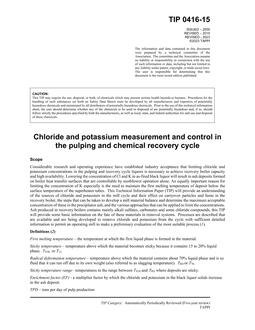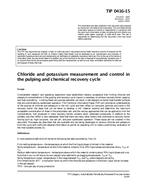Considerable research and operating experience have established industry acceptance that limiting chloride and potassium concentrations in the pulping and recovery cycle liquors is necessary to achieve recovery boiler capacity and high availability. Lowering the concentration of Cl and K in as-fired black liquor will result in ash deposits formed on boiler heat transfer surfaces that are controllable by sootblower operation alone. An equally important reason for limiting the concentration of K especially is the need to maintain the first melting temperature of deposit below the surface temperature of the superheater tubes. This Technical Information Paper (TIP) will provide an understanding of the sources of chloride and potassium in the mill cycle and their effect on carryover particles and fume in the recovery boiler, the steps that can be taken to develop a mill material balance and determine the maximum acceptable concentration of these in the precipitator ash, and the various approaches that can be applied to limit the concentrations. Ash produced in recovery boilers contains mainly alkali sulfates, carbonates and some chloride compounds, this TIP will provide some basic information on the fate of these materials in removal systems. Processes are described that are available and are being developed to remove chloride and potassium from the cycle with sufficient detailed information to permit an operating mill to make a preliminary evaluation of the most suitable process (1).
Product Details
- Published:
- 03/01/2023
- Number of Pages:
- 21
- File Size:
- 1 file , 1.1 MB
- Note:
- This product is unavailable in Ukraine, Russia, Belarus

